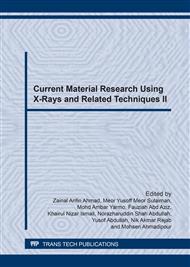p.382
p.389
p.394
p.400
p.404
p.409
p.413
p.418
p.423
Reduction of Molybdenum Trioxide by Using Hydrogen
Abstract:
Metallic molybdenum was synthesized through reduction of molybdenum trioxide (MoO3) by using hydrogen as a reducing agent. The reduction behavior of MoO3 were investigated by using temperature programmed reduction (TPR). The reduced phases were characterized by X-ray diffraction spectroscopy (XRD). The XRD results indicate that the reduction of MoO3 proceed in two steps reduction (MoO3 → MoO2 → Mo) with formation of intermediate phases of Mo4O11 during first step of reduction. However, the TPR results showed only one broad peak that correspond to all reduction step that was merge into one peak. It seem that, increasing the temperature cause the rapid reduction that correlated with thermodynamic consideration data that show the formation of metallic molybdenum is become feasible by increasing the temperature.
Info:
Periodical:
Pages:
404-408
Citation:
Online since:
March 2017
Keywords:
Price:
Сopyright:
© 2017 Trans Tech Publications Ltd. All Rights Reserved
Share:
Citation:


